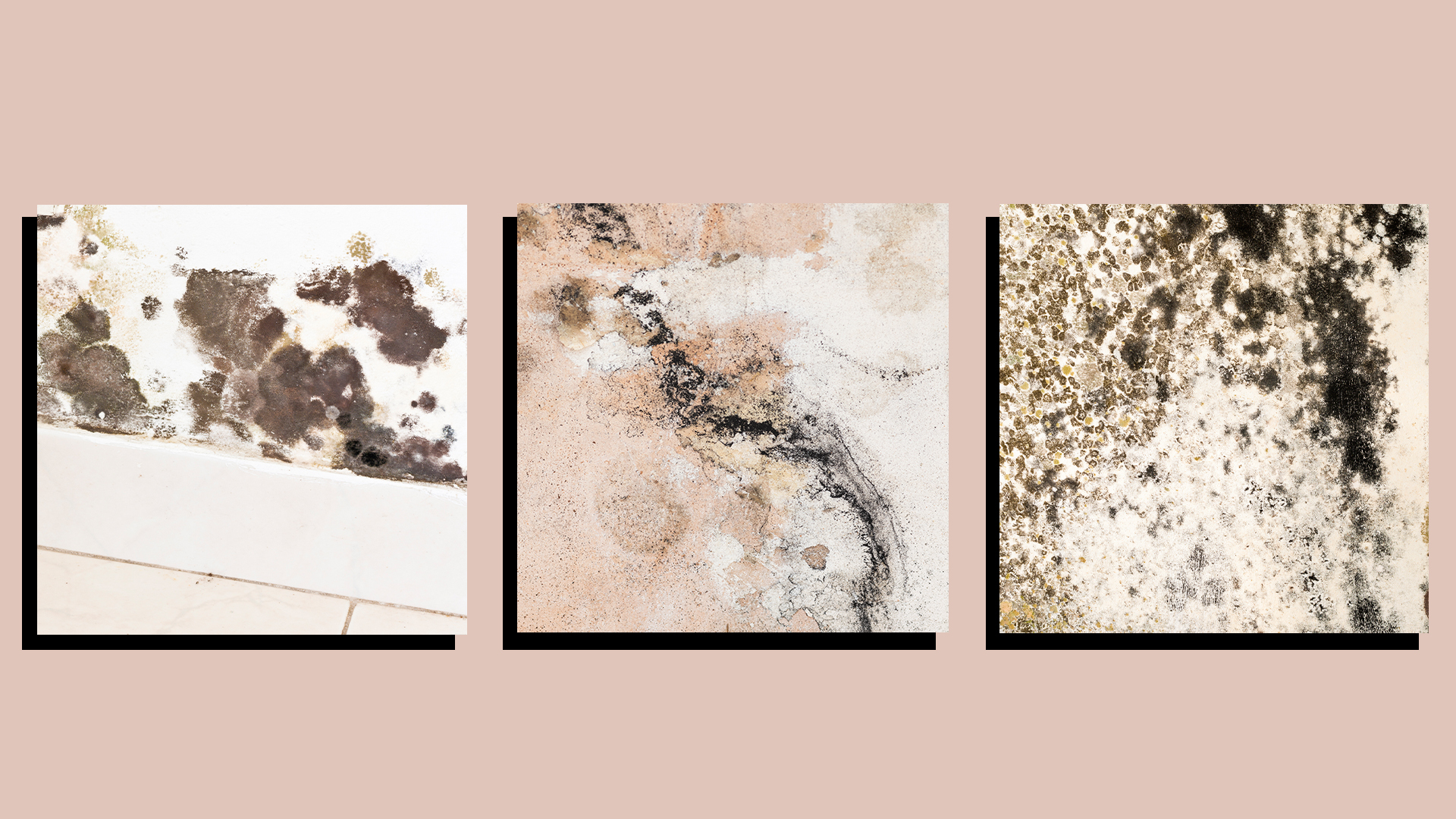A black mold removal guide—how to get rid of mold safely and effectively
Removing black mold can seem like a daunting task, but our easy-to-follow guide will help you get rid of mold quickly and safely

Black mold isn't just unpleasant, it can be dangerous. Black mold is a fungus that develops from spores, and it requires a food source, a place to grow, oxygen, and moisture to develop. Yes, there are associated health risks and it's important to tackle the issue quickly, but discovering black mold needn't be a reason to panic.
While it is potentially harmful to your health, black mold removal doesn't have to be scary if you are well prepared and know what steps to take. "Although there are several types of mold that are found in the home, the dreaded ‘black mold’ is the one people seem to fear the most. For some people, who are only mildly sensitive to it, it can cause a runny nose or sore throat. For others who are more sensitive to allergies, or have asthma, mold can increase the already serious conditions," Sara Ashdown, Cleaning Product Expert at Brandrated told w&h.
If you follow these specific steps below to be safe while cleaning black mold, you will protect yourself, and make sure that it's gone for good. Along with the below suggestions, try using an air purifier, and limit excess moisture in the home to help prevent black mold from coming back (you might want to take a look at our guide to the best air purifiers if you don't own one already).
If you're in need of some more cleaning tips when it comes to difficult areas of the home, check out our guides on how to clean a toilet, how to get stains out of carpet, and how to clean a washing machine.
Preparing to clean black mold
Like an arduous cleaning task, preparation is key and you'll need the right tools to get the job done well. It's important to wear adequate protection when it comes to black mold removal, as there are some serious health risks associated with ingesting it. “Black mold or Stachybotrys Chartarum is a type of toxic mold that can cause several health problems, including eye inflammation and damage to the eyeballs. It has also been proven to kill neurons in the brain, resulting in neurological issues that can lead to seizures and tremors," Heather Barrigan, cleaning expert at MyJobQuote.co.uk told w&h.
Follow these steps to help you identify your black mold source before cleaning.
1. Find the source of the mold
You don't always see black mold before it's a problem. Often, you will smell the mold before you see it. Moisture sources can occur in many spaces, but below are a few common ones.
Sign up to our free daily email for the latest royal and entertainment news, interesting opinion, expert advice on styling and beauty trends, and no-nonsense guides to the health and wellness questions you want answered.
- Fixtures and taps on showers—as well as bathtubs, and sinks can grow black mold over time through water leakage.
- Leaking or damaged pipes—especially if located in warmer temperatures, can create black mold in places like basements.
- Leaks in your water heater—this can create black mold in the basement, or wherever your water heater is located.
2. Identify it as black mold
Black mold can be identified by its distinctive qualities. Black mold is black or dark grey and often has a wet and musty smell. It grows in areas with a lot of moisture and may cause you to have a burning or scratching feeling in your throat or lungs. It will be black, or deep green, in appearance. Black mold doesn't require a different cleaning method to other types of mold, but due to its associated health risks, you'll want to carry out black mold removal quickly.
3. Make your own black mold cleaner
While there are many chemical solutions that you can find at a hardware store, some natural ingredients can also remove black mold without the added toxicity. Popular choices are tea tree oil and grapefruit seed extract.
To create your DIY cleaning solution, mix a ratio of one cup water to one teaspoon of either tea tree oil or grapefruit seed extract. You can also use bleach to treat the area, mixing one part bleach with two parts water.
4. Prepare yourself and the area
Before dealing with the mold, you need to prep the area and make sure you are protected while cleaning to avoid inhaling the mold or allowing it to spread.
Start with these steps:
- Wear a respirator mask to protect against spores.
- Wear as much clothing as you need to cover your skin. Disposable coveralls are a good way to ensure black mold does not attach to your clothing after you've removed them. If you don't have any, pop your clothes into the wash once you are finished.
- Wear safety goggles and rubber gloves.
- Once you are adequately dressed, turn off your air conditioner, heater, or central air system. You don't want air moving while you are removing black mold.
- Seal any doorways in the room to stop mold spores from traveling while you are working.
- Use an exhaust fan near outdoor openings to move airborne spores out of your home.
- Check the area for moisture. If there is none, spray the mold with water to stop mold spores from going airborne.
Black mold removal in four steps
Cleaning black mold should be done carefully. Skipping steps or rushing can cause the mold spores to spread, risking health issues for you and your family, as well as the added headache of cleaning another infected area of your house.
Once you've got into your safety clothes and prepared the area, these are the steps you should take:
1. Spray the area with your cleaning solution
Armed with your spray bottle of water and tea tree oil or grapefruit seed extract, or bleach, identify the area that needs to be sprayed down.
Shake the bottle to ensure that the solution is properly mixed since the oils and water tend to separate after a while. Saturate the area completely with the solution and let it rest for five to ten minutes to allow the solution to kill the spores.
2. Scrub the area with black mold using a nylon bristle brush
It's important to avoid splashing or sending the cleaning solution with black mold into the air. Scrub with firm, slow strokes, picking up as much of the mold as you can. Respray with your freshly shaken solution and scrub again. Black mold can be stubborn, so be patient and repeat as necessary. Wipe up any dislodged mold with a paper towel and dispose of it in a heavy-duty garbage bag.
3. Re-spray and air dry
Since the essential oils or bleach in the cleaning solution will continue to fight any remaining black mold, respray the area thoroughly and let the area air dry. This will also help remove any lingering odor caused by the black mold spores.
4. Clean up the area and your cleaning gear
Since black mold can spread very easily from surface to surface, as well as in the air, it's best to isolate all cleaning agents used until they are properly sanitized or thrown away. Disposable coveralls can be tossed in the trash along with any other rags or paper towels you wish to throw away.
Tie up the bag well to ensure no air escapes and throw it away immediately in a designated trash area outside your house. Do not leave it lingering in your garage or basement.
After removing goggles, plastic gloves, and overalls, soak and wash the lot—along with your scrubbing brush— in hot water.
Black mold should be taken seriously, but don't let it scare you. With the proper cleaning tools and precautions, you can wave goodbye to this annoying fungus.
Amy Hunt is an experienced digital journalist specialising in homes, interiors and hobbies. She began her career working as the features assistant at woman&home magazine, before moving over to the digital side of the brand where she eventually became the Lifestyle Editor up until January 2022. Amy won the Digital Journalist of the Year award at the AOP Awards in 2019 for her work on womanandhome.com.

